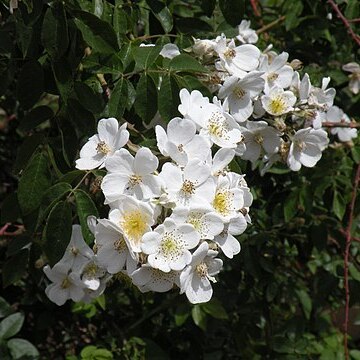Shrubs climbing or scandent, 4–6 m. Branchlets red-brown or purple-brown, terete, pubescent when young, glabrate; prickles scattered, curved, to 5 mm, flat, gradually tapering to broad base. Leaves including petiole 6–9 cm; stipules mostly adnate to petiole, free parts lanceolate, both surfaces pubescent, margin glandular, apex acuminate; rachis and petiole densely pubescent, with scattered small, curved prickles; leaflets 7, often 5 or 3 on leaves near corymb, oblong or oblong-lanceolate, 3–5 × 1–1.5 cm, abaxially glabrous, adaxially sparsely pubescent or rarely glabrous, base subrounded or broadly cuneate, margin serrate, apex acuminate or acute. Flowers numerous in compound corymb, 3–5 cm in diam.; pedicel 2.8–3.5 cm, pubescent and sparsely glandular-pubescent; bracts sometimes a unifoliolate leaf at base of inflorescence; bracteoles tiny or absent. Hypanthium obovoid, abaxially pubescent. Sepals 5, deciduous, lanceolate, both surfaces pubescent, often with 1 or 2 pairs of lobes, apex acuminate. Petals 5, white, fragrant, broadly obovate, base broadly cuneate, apex emarginate. Styles connate into column, exserted, slightly longer than stamens, pubescent. Hip purple-brown or dark red, ovoid, ca. 1 cm in diam., glabrous, shiny. Fl. Jun, fr. Jul–Nov.
More
A straggling shrub or rambling climber. The leaves have stalks. They are divided into 7 or 9 leaflets. These have short stalks. The leaflets are oblong with a short tip and they have teeth along the edge. They are hairy on the veins underneath. The flowers are white. They occur at the ends of branches in a flat topped arrangement where the outer flowers open first. The fruit are dark brown and round. They are 10-15 mm long.

